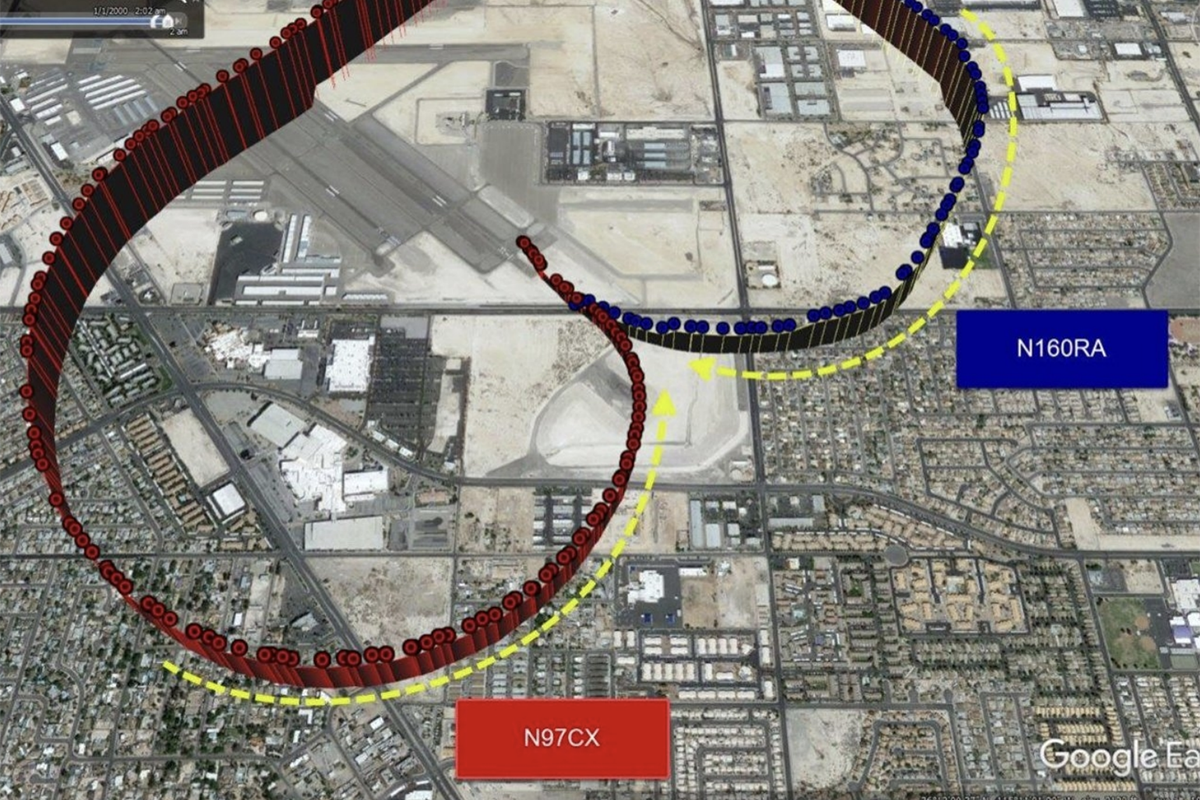
The ADS-B track from the NTSB’s preliminary report shows chilling flight paths for the accident aircraft at KVGT. [Image: NTSB]
The National Transportation Safety Board has released its preliminary report regarding the investigation into the midair collision of two aircraft at North Las Vegas Airport (KVGT). The accident happened on July 17. Four people were killed when a Piper Malibu Mirage and a Cessna 172 collided while on approach to Runway 30R around noon in clear, sunny skies.
The airport has parallel runways: 30L, measuring 5,000 feet by 75 feet, and 30R, which measures 4,199 feet by 75 feet.
The approach end of Runway 30L is approximately 1,000 feet north of the approach end of Runway 30R. Runway 30L is a non-precision runway. Runway 30R is a precision runway with aiming point and touchdown zone markings, which help distinguish it visually from 30L.
A husband and wife were aboard the Piper. According to a radio transmission made to another pilot in the pattern, the couple in the Piper were flying in from Idaho. The occupants of the Cessna were a flight instructor and learner in the pattern for Runway 30R, practicing takeoffs and landings.
According to the NTSB preliminary investigation, both airplanes were in contact with the tower at the time of the accident.
The Piper had been cleared to land on Runway 30L and had acknowledged the clearance three times in three separate transmissions, but continued flying toward 30R.
The collision occurred approximately 0.25 miles from the approach end of Runway 30R.
Accident Timeline
1156:08
Piper N97CX is on an IFR flight plan and approaching from the north. Nellis Radar Approach Control clears N97CX for the visual approach at KVGT and instructs the pilot to overfly the airport at midfield for left traffic to Runway 30L.
1158:26
Air traffic control responsibility for the flight is transferred from Nellis Radar Approach Control to the North Las Vegas tower, and Piper N97CX is instructed to fly left traffic for Runway 30L.
Meanwhile, Cessna N160RA is instructed to fly right traffic for Runway 30R. The ADS-B records for the day show the Cessna had already made several laps in the pattern for 30R.
1158:43
The pilot of N97CX contacts KVGT tower and reports: “Descending out of 7,600 feet msl for landing on three zero left and ah Nellis said to cross midfield.”
The tower controller replies, “Continue for three zero left.”
The pilot acknowledges the transmission with, “Okay continue for runway three zero left nine seven charlie x-ray, we will cross over midfield.”
1200:03
The pilot of N160RA requests a “short approach.”
The tower controller replies, “zero romeo alpha short approach approved, runway three zero right, cleared for the option."
Cessna N160RA acknowledges the transmission.
1201:36
The tower controller transmits, “November seven charlie x-ray runway three zero left cleared to land.”
The pilot of N97CX responds, “Three zero left cleared to land nine seven charlie x-ray.”
The ADS-B track shows the Piper in a left turn, but it does not appear to be lining up with Runway 30 Left, rather the aircraft is swinging wide as if to land on the parallel Runway 30R.
1201:57
The tower controller transmits, “Seven charlie x-ray I think I said it right, runway three zero left, seven charlie x-ray runway three zero left.”
The pilot of N97CX replies, “Yeah, affirmative runway three zero left, that’s what I heard nine seven charlie x-ray.”
This is the final transmission from both aircraft, and they collide approximately a quarter of a mile from the approach end of Runway 30R.
The FAA illustration included in the NTSB report based on the ADS-B data shows both aircraft had lined up for Runway 30R.
Witnesses on the ground reported seeing the right wing of the Piper and the left wing of the Cessna collide before both aircraft plunged to the ground.
Photographs of the Piper wreckage show the Piper fuselage primarily intact. The NTSB report mentioned longitudinal scratches were visible along the right side of the fuselage.
The NTSB also noted damage to the Piper's right wing, including "impact separation" and the right inboard wing section, which remained attached to the fuselage, was canted aft. The right wing flap was fractured about midspan. The crush impressions to the leading edge of the wing contained flakes of green primer, and there were cuts to the de-ice boot.
The Cessna, missing most of the left wing, hit the ground in a nose-low attitude, coming to rest inverted on a 304-degree magnetic heading. Also, the aircraft burned, the report said.
According to the NTSB, "About 4 [feet] of the left wing, which included the left aileron, was separated from the left wing, and was found on the edge of a culvert just south of the main wreckage. The left outboard wing section aft of the forward spar was found to be separated near the aileron-flap junction. The left wing flap was found to be separated from the wing."
Blue paint transfer was found on the lower surface of the separated left wing and the lower surface of the left wing flap. Black de-ice boot material transfer was observed on the lower surface of the separated outboard left wing, and the lower surface of the attached portion of the left wing, stretching about 5 feet outboard of the strut attach point, along the lower leading edge.
Most of the Cessna was consumed by fire, excluding the cabin roof.
The final report will be released at the conclusion of the investigation. NTSB investigations can take a year to 18 months to complete.

Sign-up for newsletters & special offers!
Get the latest FLYING stories & special offers delivered directly to your inbox






